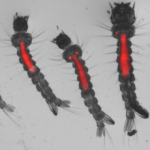Lien vers Pubmed [PMID] – 20019799
PLoS Pathog. 2009 Dec;5(12):e1000694
The systemic immune response of Drosophila is known to be induced both by septic injury and by oral infection with certain bacteria, and is characterized by the secretion of antimicrobial peptides (AMPs) into the haemolymph. To investigate other possible routes of bacterial infection, we deposited Erwinia carotovora (Ecc15) on various sites of the cuticle and monitored the immune response via expression of the AMP gene Diptericin. A strong response was observed to deposition on the genital plate of males (up to 20% of a septic injury response), but not females. We show that the principal response to genital infection is systemic, but that some AMPs, particularly Defensin, are induced locally in the genital tract. At late time points we detected bacteria in the haemolymph of immune deficient Relish(E20) flies, indicating that the genital plate can be a route of entry for pathogens, and that the immune response protects flies against the progression of genital infection. The protective role of the immune response is further illustrated by our observation that Relish(E20) flies exhibit significant lethality in response to genital Ecc15 infections. We next show that a systemic immune response can be induced by deposition of the bacterial elicitor peptidoglycan (PGN), or its terminal monomer tracheal cytotoxin (TCT), on the genital plate. This immune response is downregulated by PGRP-LB and Pirk, known regulators of the Imd pathway, and can be suppressed by the overexpression of PGRP-LB in the haemolymph compartment. Finally, we provide strong evidence that TCT can activate a systemic response by crossing epithelia, by showing that radiolabelled TCT deposited on the genital plate can subsequently be detected in the haemolymph. Genital infection is thus an intriguing new model for studying the systemic immune response to local epithelial infections and a potential route of entry for naturally occurring pathogens of Drosophila.

